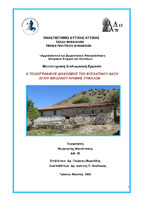| dc.contributor.advisor | Βαρελίδης, Γεώργιος | |
| dc.contributor.author | Μητσάτσικας, Μαργαρίτης | |
| dc.date.accessioned | 2022-04-13T10:25:53Z | |
| dc.date.available | 2022-04-13T10:25:53Z | |
| dc.date.issued | 2022-03-30 | |
| dc.identifier.uri | https://polynoe.lib.uniwa.gr/xmlui/handle/11400/2124 | |
| dc.identifier.uri | http://dx.doi.org/10.26265/polynoe-1975 | |
| dc.description.abstract | Ο ναός του Αγίου Νικολάου Κρήνης Τρικάλων, είναι ένα από τα αξιόλογα βυζαντινά μνημεία που φιλοξενεί η Θεσσαλική ύπαιθρος. Είναι κτίσμα του 13ου αιώνα , που φέρει εξαιρετικά αρχιτεκτονικά στοιχεία στην κατασκευή του κελύφους του και αξιόλογο τοιχογραφικό διάκοσμο, ο οποίος έχει κατασκευαστεί στη βυζαντινή και μεταβυζαντινή περίοδο. Στις μέρες μας, διαπιστώνουμε ότι το μνημείο αυτό έχει υποστεί σημαντικές αλλοιώσεις τόσο στην αρχική κτιριακή του υπόσταση, όσο και στην κατάσταση διατήρησης του τοιχογραφικού διακόσμου του. Το πέρασμα των χρόνων, οι καιρικές συνθήκες, αλλά και οι ανθρώπινες επεμβάσεις είναι οι κυριότερες αιτίες των μεταβολών που υπέστη το μνημείο.
Το εικονογραφικό πρόγραμμα που εφαρμόστηκε, καλύπτει το σύνολο των επιφανειών του ναού και κατέχεται από σαφήνεια, αρμονία και πληρότητα, δίνοντας έμφαση στις παραστάσεις του Χριστολογικού και Θεομητορικού κύκλου, που ιστορούν την άνω ζώνη του τοιχογραφικού διακόσμου του ναού. Στο ιερό βήμα παρατηρούμε με δέος τις παραστάσεις του βυζαντινού διακόσμου, οι οποίες ανήκουν στον Ευχαριστιακό κύκλο, ενώ στη μεσαία ζώνη, ιστορείται πλήθος Αγίων σε μετάλλια, καθώς και ολόσωμοι Αγιοι στην κάτω ζώνη, οι οποίοι διατάσσονται παρατακτικά. Σχετικά με την κατάσταση διατήρησης του τοιχογραφικού διακόσμου, διαπιστώνουμε ότι τόσο το βυζαντινό στρώμα τοιχογραφιών, το οποίο διατηρείται κυρίως στο χώρο του ιερού, όσο και ο μεταγενέστερος μεταβυζαντινός διάκοσμος, έχουν αλλοιωθεί σε σημαντικό βαθμό, λόγω των φθορών που υπέστησαν οι τοιχογραφίες από την ύπαρξη αυξημένης υγρασίας, αλλά και από ανθρώπινες δραστηριότητες. Παρατηρούμε καταρρεύσεις τμημάτων τοιχογραφικού διακόσμου, κυρίως λόγω υγρασίας στην κάτω ζώνη του βόρειου τοίχου του κυρίως ναού, αποκολλήσεις από το υποστήριγμα, αλλά και σημαντική δραστηριότητα επιζωγραφίσεων. Διαπιστώνουμε επίσης, ότι τμήματα του αρχικού βυζαντινού διακόσμου, τα οποία παρατηρούνται σε σημεία στο εσωτερικό του ναού, επικαλύπτονται από τις μεταγενέστερες τοιχογραφίες. Οι δυο κατεστραμμένες επιγραφές του μνημείου, δυστυχώς μας αποκόπτουν από πληροφορίες, οι οποίες θα ήταν σημαντικές για την αναγνώριση του καλλιτέχνη που φιλοτέχνησε το μεταβυζαντινό στρώμα. Η μελλοντική ανάδειξη του μνημείου, τόσο από πλευράς αναστήλωσης του, όσο και από πλευράς συντήρησης του τοιχογραφικού διακόσμου, θα μας βοηθήσουν στη συνέχεια της έρευνας, προσφέροντας μας στοιχεία, τα οποία μέχρι σήμερα μας είναι άγνωστα. | el |
| dc.format.extent | 103 | el |
| dc.language.iso | el | el |
| dc.publisher | Πανεπιστήμιο Δυτικής Αττικής | el |
| dc.rights | Αναφορά Δημιουργού - Μη Εμπορική Χρήση - Παρόμοια Διανομή 4.0 Διεθνές | * |
| dc.rights.uri | https://creativecommons.org/licenses/by-nc-sa/4.0/deed.el | * |
| dc.subject | Τοιχογραφικός διάκοσμος | el |
| dc.subject | Τοιχογραφίες | el |
| dc.subject | Εικονογραφικό πρόγραμμα | el |
| dc.title | Ο τοιχογραφικός διάκοσμος του βυζαντινού ναού αγίου Νικολάου Κρήνης Τρικάλων | el |
| dc.title.alternative | The mural decoration of the byzantine church of agios Nikolaos Krini Trikala | el |
| dc.type | Μεταπτυχιακή διπλωματική εργασία | el |
| dc.contributor.committee | Κουρνιάτης, Νικόλαος | |
| dc.contributor.committee | Vryzidis, Isaak | |
| dc.contributor.faculty | Σχολή Μηχανικών | el |
| dc.contributor.department | Τμήμα Πολιτικών Μηχανικών | el |
| dc.contributor.master | Αρχιτεκτονική και Δομοστατική Αποκατάσταση Ιστορικών Κτιρίων και Συνόλων | el |
| dc.description.abstracttranslated | The church of Agios Nikolaos Krini, Trikala, is one of the remarkable Byzantine monuments, hosted by the Thessalian countryside. It is a building of the 13th century, which has exceptional architectural elements in the construction of its shell, and a remarkable mural decoration, which has been constructed in the Byzantine and post-Byzantine period. Nowadays we find that this monument has undergone significant alterations, both in its original building and in the state of preservation of its mural decoration. The passage of time, the weather conditions, but also the human interventions, are the main causes of the changes that the monument has undergone. The iconographic program that was applied, covers all the surfaces of the temple, and is possessed by clarity, harmony, and completeness, emphasizing the representations of the Christological and Theomitary cycle, which tell the story of the upper zone of the fresco decoration of the temple. In the sanctuary we observe with awe, the representations of the Byzantine decoration, which belong to the Eucharistic circle, while in the middle zone, there is a multitude of saints in medals, as well as full-length saints in the lower zone, who are arranged in a row. Regarding the state of preservation of the fresco decoration, we find that both the Byzantine layer of frescoes, which is preserved mainly in the sanctuary, and the later post-Byzantine decoration, have been significantly altered, due to the damage suffered by the frescoes from the frescoes. moisture, but also from human activities. We observe collapses of parts of mural decoration, mainly due to humidity, in the lower zone of the north wall of the main church, detachments from the support, but also significant painting activity. We also find that parts of the original Byzantine decoration, which are observed in places inside the church, are overlapped by later frescoes. The two damaged inscriptions of the monument, unfortunately, cut us off from information, which would be important for the identification of the artist who created the post-Byzantine layer. The future development of the monument, both in terms of its restoration and in terms of maintenance of its mural decoration, will help us to continue the research, providing us with data that are still unknown to us. | el |



